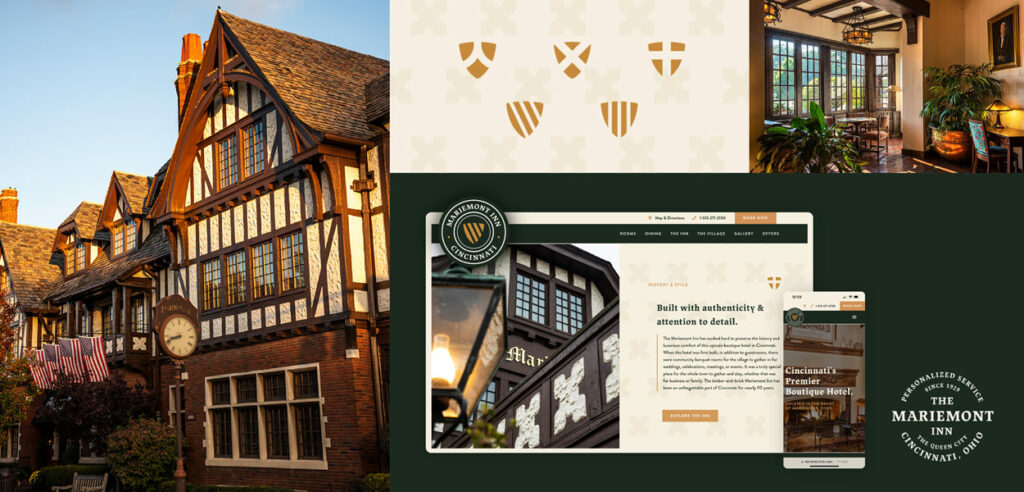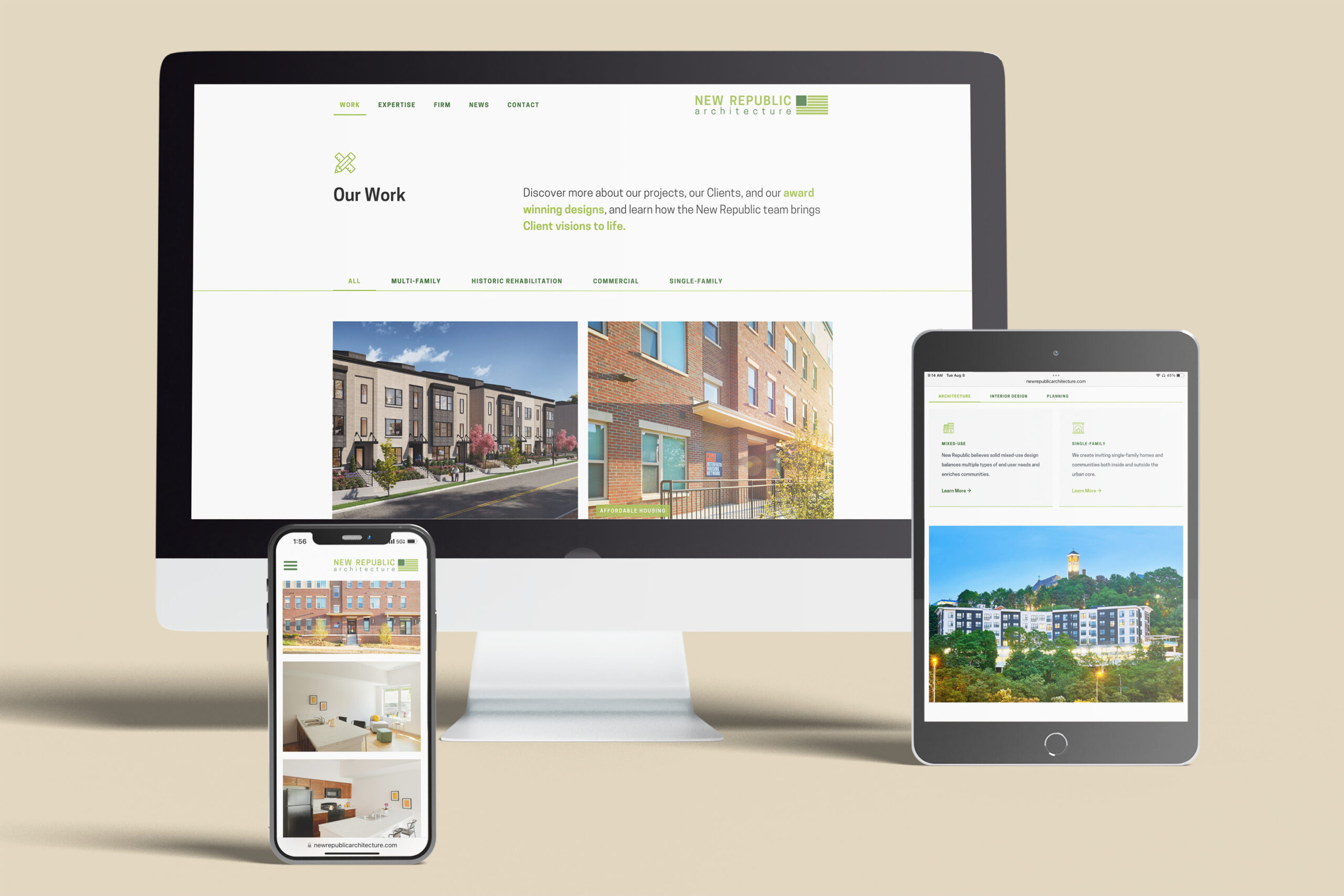Staying relevant is paramount to helping you gain and maintain a competitive edge. Rebranding or brand development are two strategies companies often employ to ensure their consistent relevance and competitiveness. But how do you know if your business is due for a rebrand? Do you need a full rebrand or just brand development? What’s the difference? We’ll explore why brand identity is important, the difference between a rebrand and brand development projects, and provide five indicators we’ve heard from clients for why it might be time for you to consider a rebrand or brand development.
Why is brand identity important?
Okay, so think of your brand as the personality of your business. It’s the essence of who you are and what you’re all about. A killer brand identity sets you apart from the crowd, keeps customers coming back for more, and helps your business grow. But hey, things change, right? Trends shift, people’s tastes evolve, and businesses grow and adapt. That’s why it’s super important to occasionally take a step back and see if your brand still hits the mark. These are just a few of benefits we see from a well constructed brand identity.
1. Recognition and Differentiation
Think about walking down a busy street filled with coffee shops. The one with the bright red logo or the quirky name stands out, right? That’s the power of a strong brand identity. It’s like wearing a unique outfit at a party; people notice you and want to know more.
2. Trust and Credibility
Imagine you’re shopping online for a new gadget. You stumble upon two websites selling the same thing. One has a sleek, professional design with clear branding, while the other looks like it was thrown together in five minutes. Which one are you more likely to trust with your hard-earned cash? Exactly. Consistency breeds trust.
3. Emotional Connection
Remember that Cetaphil Super Bowl commercial with the dad and daughter bonding over football and Taylor Swift that made you tear up (don’t lie) or, that Uber Eats “in order to remember something, you have to forget something” ad that made you laugh out loud? That’s the magic of brand identity. When a brand speaks to you on a personal level or aligns with your values, it’s like finding a friend in a crowded room. You want to stick around and see what they’ll do next.
4. Consistency Across Platforms
Ever visited a website, then checked out their Instagram, only to wonder if you’re looking at the same brand? Inconsistency is confusing. A strong brand identity ensures that whether you’re browsing their website, flipping through their brochure, or scrolling through their social media, you always know it’s the same awesome brand.
5. Brand Loyalty and Advocacy
Remember that restaurant you always rave about to your friends? It’s not just about the food; it’s the whole experience—the cozy atmosphere, the friendly staff, the mouthwatering smells. That’s the power of a strong brand identity. It creates loyal fans who can’t wait to tell everyone about their amazing experiences.
6. Competitive Advantage
Picture yourself at a farmer’s market with dozens of stalls selling handmade soaps. They all smell divine, but one catches your eye with its charming packaging and catchy tagline. It’s takes something unique to stand out in a crowded market and sometimes it doesn’t need to be that complex. A strong brand identity helps you shine brighter than the rest.
7. Value Perception
Think about your favorite brand of sneakers. Sure, they might cost a little more than others, but you know they’ll last longer and make you look cooler than ever. That’s the power of perception. A strong brand identity elevates your value in the eyes of your customers, making them willing to pay a little extra for the experience.
What does it mean to rebrand?
Rebranding isn’t just about updating your logo or changing your company’s name. It’s a strategic look at your brand’s identity, messaging, and positioning. It involves an analysis of your current brand perception, market trends, and competitive landscape to identify areas for improvement and opportunities for differentiation. Rebranding may encompass changes to your visual identity, such as logo, colors, and typography, as well as your brand’s voice, messaging, and even your products or services.
What is the difference between a full rebrand and brand development?
Brand development is all about refinement of your brand and its various elements. It’s about fine-tuning your logo, colors, typography, and overall visual style to better reflect who you are and what you stand for. It’s like polishing up the exterior of your house—adding a fresh coat of paint, updating the fixtures, and sprucing up the landscaping.
Now, rebranding in this context is like giving your room a total makeover. Maybe your old color scheme feels outdated, or your logo doesn’t quite capture the essence of your brand anymore. Rebranding involves making more significant changes to your visual identity—like redesigning your logo, changing your brand colors, or updating your website layout. It’s like knocking down walls, installing new flooring, and completely transforming the space to better suit your current style and needs.
So, while brand development focuses on making incremental improvements to enhance your brand’s visual appeal and consistency, rebranding involves more substantial changes to refresh and modernize your entire visual identity. Both are important steps in keeping your brand looking fresh and relevant.
The 5 signs your business should consider a rebrand or brand development.
1. Outdated Visual Identity
If your logo, website, or marketing materials look like they belong in a different era, it’s a clear sign that your brand might need a refresh. An outdated visual identity can make your business appear stagnant and disconnected. There a many aspects of a rebrand including logo design, messaging, illustrations and infographics, and other visual design elements to help set your brand apart. If your brand has become indistinguishable from competitors or if your value proposition no longer sets you apart in the market, rebranding can help you redefine what makes your business unique and reignite consumer interest.
2. Changing Target Audience or Services
As your business evolves, your target audience may shift as well. If you find that your current branding no longer resonates with your ideal customers or fails to attract a new demographic you’re targeting, it may be time to rebrand to better align with their preferences and values. When businesses expand into new markets, launch new products or services, or undergo significant changes in their offerings, rebranding can help communicate these changes effectively to customers and stakeholders. A cohesive brand identity ensures consistency and clarity across all touchpoints.
3. Mergers or Acquisitions
In cases of mergers or acquisitions, rebranding is often necessary to integrate the newly acquired entities into a unified brand identity. Rebranding can help consolidate disparate brand identities, align messaging, and signal a fresh start for the combined entity.
4. Messaging is unclear
Rebranding is not just about changing your company name or logo. It can also be the solution to fix unclear messaging. If your brand message is not clear, you risk confusing or alienating potential customers, which can hurt your bottom line. You can also accomplish this with singular brand development exercises that allow you to take a fresh look at your messaging, reassess your target audience, and develop a strategy to effectively communicate who you are and what you offer. By creating a clear and consistent brand message, you can attract more customers, increase brand loyalty, and ultimately grow your business.
5. Poor Brand Awareness or Recognition
Your customers should interact with your brand across a number of physical and digital touchpoints and all of them are important to brand recall. Integrated design and development services allow for a holistic problem-solving approach across all of those touchpoints. Designers and developers can collectively address challenges, leveraging their combined expertise to find optimal solutions. This synergy enhances the overall quality of the end product and ensures that both design and functionality are prioritized throughout the process.
Visual branding & identity serve as the immediate and enduring language of a brand, influencing perceptions, building trust, and fostering recognition.
At Expedition, we create visual identities that not only shape the perception of a brand but also resonate deeply with audiences, forging a memorable and recognizable presence.
In conclusion, why should I care about a rebrand or brand development?
To wrap things up, staying relevant is crucial for keeping your business ahead of the game. That’s where strategies like rebranding and brand development come into play—they help you stay fresh and competitive. But figuring out if you need a full-on rebrand or just some tweaks can be tricky, right? Throughout this article, we’ve chatted about why your brand identity is super important, sorted out the difference between a full rebrand and smaller brand development projects, and shared five signs, straight from our clients, that could signal it’s time for a change. With these insights in your back pocket, you’ll be better equipped to steer your brand toward success in today’s dynamic marketplace.
Every great idea starts with a conversation — and we want to have it. Schedule a call today, and we’d be happy to see if our team is the right fit.
Too long; didn't read FAQs
How does brand identity benefit my business?
A killer brand identity helps you stand out in a crowded market, build trust and credibility, forge emotional connections with your audience, maintain consistency across platforms, cultivate brand loyalty and advocacy, gain a competitive advantage, and enhance the perceived value of your offerings. In short, it’s a powerful tool for growing and sustaining your business.
What kinds of things do you do for a rebrand?
A rebranding can take many forms. Understanding your brand’s creative direction is the first and foremost aspect to dive into. You can then begin to uncover the target audience, messaging, goals, and strategy behind not only the visual identity of your brand but how the entire image is perceived to your customers and audience.
What's the difference between a full rebrand and brand development?
Brand development is like giving your brand a makeover with small tweaks and refinements. On the other hand, a full rebrand is like a total transformation which may involve making significant changes to your messaging and visual identity.
While brand development focuses on gradual improvements, rebranding is about a complete overhaul to keep your brand fresh and relevant. Both are essential for maintaining your brand’s appeal and consistency.
How long does a rebranding process take?
The rebranding process duration varies depending on the complexity and scope of the project. It is also important to consider the external factors that may affect the timeline, such as market conditions, competitors’ activities, and regulatory requirements. To ensure a successful rebranding, it is crucial to establish clear goals, timelines, and communication channels, and to allocate sufficient resources and budget. Because of this, the timeline for a rebranding process should be carefully planned and managed to minimize disruption to the business and ensure that the desired outcomes are achieved.






